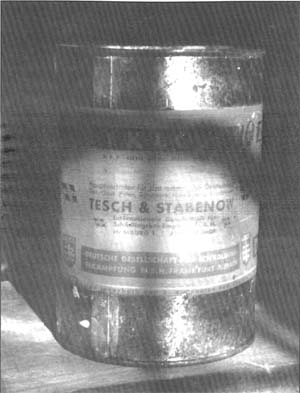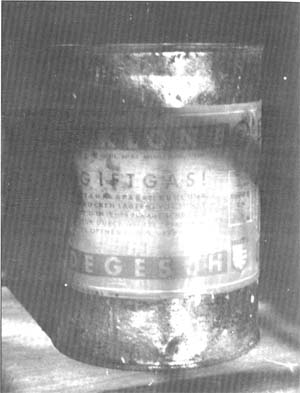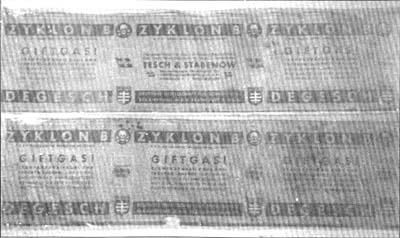from Wolbrom called Lejb. This Jew, aged about twenty, was dark and had a number of one hundred thousand and something. All the Sonderkommando working in the crematorium [Kr V] were assembled, and before their eyes he was hung, with his hands tied behind his back, from an iron bar above the firing hearths. He remained in this position for about ane hour, then after untying his hands and feet, they threw him in a cold crematorium furnace. Gasoline was poured into the lower ash bin [that of the firebox at the back of the furnace] and lit. The flames reached the muffle where this Lejb was imprisoned. A few minutes later. they opened the door and the condemned man emerged and ran off, covered in bums. He was ordered to run round the yard shouting that he was a thief. Finally, he had to climb the barbed wire, which was not electrified during the day. and when he was at the top, the head of the crematoriums, Moll, first name Otto [Hauptscharführer / Master sergeant], killed him with a shot. Another time, the SS chased a prisoner who was not working fast enough into a pit near the crematorium [V] that was full of boiling human fat. At that time [summer 1944]. the corpses were incinerated in open air pits, from which the fat flowed in to a separate reservoir, dug in the ground. This fat was poured over the corpses to accelerate their combustion. This poor devil was pulled out of the fat still alive and then shot. To satisfy the formalities, his body was carried to the block where the death certificates ("Totenchein") were issued. The next day. the corpse was brought back to the crematorium [Kr V],where it was incinerated in a pit [!].
During the cremation of this first transport in mid-March 1943, we worked without interruption for 48 hours, but did not succeed in burning all the bodies, because in the meantime a Greek convoy that had just arrived was also gassed. |
[On 20th March, an RSHA convoy of 2800 Jews from Salonika (Greece) arrived. At the selection, 609 were picked out to work in the camp and the others were killed in the gas chambers. However, the interval of 48 hours between the two convoys indicated by Henryk Tauber is surely a mistake. Admittedly, there was also on 16th March, a convoy of Jews from the Cracow ghetto, some of whom were gassed, but the number of arrivals is not known, but as we know that about forty were registered in the camp, the total cannot have been more than about 200. Taking account of these imprecisions, it would appear that it took 4 to 6 days to incinerate about 1500 corpses in the five three-muflle furnaces of Krematorium II, which is very much at odds with the throughput figures previously put forward by Henryk Tauber and even by the SS OFFICIALLY (i.e. increased by one third) estimating it at 1440 per 24 hours in a letter of 28th June 1943 (PMO file BW 30/43, page 2). It is reasonable to consider that the initial throughput of Krematorium II reached a ceiling at 700 to750 incinerations a day. Then, with experience, this was raised to about 1000 Any higher figure is unrealistic, and in certain cases a downright lie.]
|
| We were overworked and completely exhausted. We were then taken back to the block and the work continued, thanks to a relief Sonderkommando that also worked at the two Bunkers and comprised about 400 prisoners. I worked in Krematorium II until about mid-April. During my stay, convoys arrived from Greece, France and Holland. In addition, we also burned the corpses of people designated for gassing at selections within the camp. I cannot say how many people were gassed during this period. We worked in two shifts. a day shift and a night shift. On average, we incinerated 2500 corpses a day. |
[This figure is unrealistic (and is connected with the propaganda of the immediate post-war period), taking into account the previous declarations of Tauber himself. It would imply that between 14th March and 15th April 1943, 70,000 to 75,000 victims could have been reduced to ashes in Krematorium II. According by Danuta Czech’s calendar of events in the camp, which despite its imperfections is an essential research tool, about 20,000 people were gassed during this period. Here we find almost the famous multiplication factor of four, of which Dr Miklos Nyiszli made such abundant and lamentable use in his book that his credibility was long contested. Henryk Tauber is far from being the only witness to say in substance “I don’t know the number of dead” or “I think it was so many” and then coolly say one or two sentences later, that after due consideration, we do arrive at the (standard) figure of 4 million victims in all. This type of imposed falsehood has to he excused, I would stress. because of the political climate of the period 1945-50].
|
| At this time I was never able to see how the people were herded into the undressing room, then from there into the gas chamber, for when the convoys arrived we were locked up in the coke store. Only the two members of the Sonderkommando who were required to keep the fires going were allowed to remain in the “boiler room”. I came to be detailed to this job myself. Through the window of the “boiler room”, I observed how the “Cyklon” [Zyklon B] was poured into the gas chamber. Each transport was followed by a vehicle with Red Cross markings which entered the yard of the crematorium. carrying the camp doctor, Mengele, accompanied by Rottenführer [corporal] Scheimetz. They took the cans of “Cyklon” [Zyklon B] from the car and put them beside the small chimneys used to introduce the “Cyklon"[Zyklon B] into the gas chamber. There, Scheimetz opened them with a special cold chisel (with a ring of teeth at its head) and a hammer, then poured the contents into the gas chamber. Then he closed the orifice with a concrete [or wooden] cover. As there were four similar chimneys, Scheimetz poured into each the contents of one of the smallest cans of “Cyklon” [Zyklon B], which had yellow labels pasted right round them [see Docunents 32, 33 and 34]. Before opening the cans, Scheimetz put on a gas mask [see Document 35] which he wore while opening the cans and pouring in the product. There were also other SS who performed this operation, but I have forgotten their names. They were specially designated for it and belonged to the “Gesundheitswesen” [health service]. A camp doctor [SS] was present at each gassing. If I have mentioned Mengele, that is because I met him very often during my work. In addition to him, there were other doctors present during the gassings, like König, Thilo, and a young, tall, slight doctor whose name I do not recall. During the selections, this last one sent everybody to be gassed. I remember that on one occasion, Mengele told Scheimetz to hurry up and “feed” the victims in the gas chamber. His actual words were: “Scheimetz, gib ihnen das Fressen, sie [?] sollen direkt nach Kattowitz fahren”. That meant that Scheimetz was to get a move on with throwing in the “Cyklon” [Zyklon B]. I also noticed during my work that the SS who escorted the convoys and came into the crematorium yards were accompanied by dogs and held truncheons in their hands. |
|
 |
|
 |
|
| Documents 32 and 33: |
| Two photographs of the same can of Zyklon B, kept in the PMO “Reserve stocks” in block 25, with a content of 1600 g. corrected to 1500 g of hydrocyanic acid, delivered by Tesch & Stalabenow, main distributor for the East Reich. Four of these cans or 6 kilograms of HCN, were used to kill 1000 to 1500 people in the Leichenkeller 1 / gas chambers of Krematorien II and III. |
| (Photos by the author) |
|
| |
 |
|
| |
Document 34: |
|
| |
Photograph of two Zyklon B can labels, kept in the PMO “Reserve stocks” in block 25. Above: 1200 gram can supplied by the distributor for the East Reich,Tesch & Stabenow. Below: 1600 grams corrected to 1500 grams supplied by the manufacturer, Degesch. |
|
| |
(Photo by the author) |
|
|

